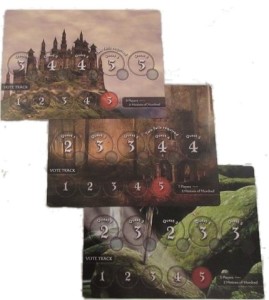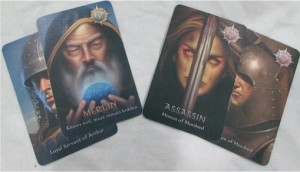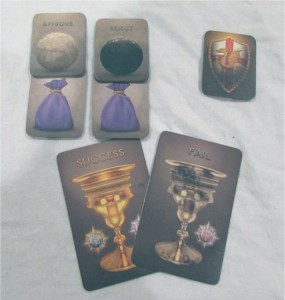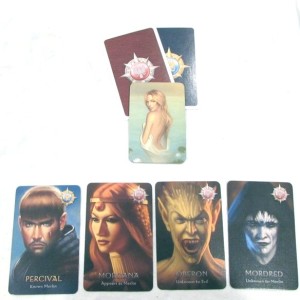So this is the first board game review for the website, so I thought I would start with a pretty simple game, that is a lot of fun to play. The game is called The Resistance: Avalon, and it is a spin-off of the original game that is simply titled The Resistance. Now we haven’t played the original game, so this review will not be factoring in the original at all. The review is broken into four main parts. Check out all I have to say about The Resistance: Avalon !
Some Quick Links:
- To get a brief overview of how to play The Resistance: Avalon, click here!
- This link will take you to the slideshow, which provides an example round of how to play.
- Check out Josh’s thoughts on the The Resistance: Avalon.
- Josh provides some insight to the advanced options for The Resistance: Avalon here.
The Resistance: Avalon: How to Play

The Resistance: Avalon game play is fairly simple. It is a game that can accommodate 5 to 10 players, and depending on the number of players, there will be a certain number of “bad guys” called Minions of Mordred, and a certain number of “good guys” which are servants of King Arthur. Now the best part of the game, is that the Minions of Mordred remain hidden from the Arthurian servants, thus making the game one of both deceit and deduction. The good guys get one little bit of help, in that one person will be playing the role of Merlin, who is hidden from the Minions of Mordred, but knows who they are. So why can’t Merlin simply just tell his allies who the Minions are? Unfortunately, Merlin is forced to remain hidden from the Minions, as at the end of the game, if evil loses, they have one saving grace, and that is attempting to guess who Merlin is. That makes Merlin’s job really complicated.
So what is the point of the game, other than endlessly arguing over who is evil and who is good? Not much really. Okay, that’s not entirely true. The game starts with people randomly picking their role after the correct number of bad guys and good guys have been added to deck. The players look at their character and through the entire game must keep that card secret. Of course, players are more than welcome to say what the card says, lie about what it says, or simply not say anything at all. After everyone is certain of their card, a short “prayer” is said, which is used to allow bad guys to identify each other, and for Merlin to identify who the bad guys are.

Game play then begins with deciding who is the first leader. The leader will be nominating other players for a vote to go on a “mission.” In the game, the good guys must complete 3 missions before they fail 3 in order to win–so it is best of five rounds. So back to the voting: the leader picks the appropriate number of players depending on what the “game board” indicates, which can range from 2 to 5 players. This number varies based on what round is being played as well as the number of players playing. Once the team is nominated, then every player gets the option to either approve the vote, or reject it. Players choose either their “approve” or “reject” tile face down, and everyone reveals the tile at the same time. For the team to succeed, the vote must be a majority of accepts. if the mission fails, then the turn shifts to the next player clockwise, and this phase of the game repeats. But good needs to prevent 5 fails, as that is an automatic game over for the good guys.

How do you succeed at the “missions”? Given that the vote for who is going on the mission is approved, it is a simple act of those players being given cards marked “success” and “fail”. Each person on the mission then chooses success or fail secretly, and the leader shuffles the cards. The leader then reveals the cards, and if all are success, then good has won the round! But if there is even one fail, evil has won the round, and now good must work to flush out who the Minion of Mordred is. So as I hope is obvious, good guys will always play a success card, while the Minions of Mordred will opt to play either success or fail, depending on how gutsy they are feeling, and how easily they think they can explain away their involvement with a failed mission.
That is essentially all there is to the game. The bad guys have to have 3 missions fail before good succeeds, while good is hoping to avoid getting fails in the missions. Given that good does prevail, the “Assassin” special Minion of Mordred gets a final guess as to who Merlin is, to hopefully steal the victory from good. The evil people get some time to discuss, but the Assassin does get the final decision on who they believe is the almighty wizard.
Example Round of The Resistance: Avalon:
[tribulant_slideshow gallery_id=”2″]
Review of The Resistance: Avalon
So, playing the game is fairly simple, and honestly pretty repetitive in The Resistance: Avalon, so how good of a game can it be? Well, in my opinion, it is one of my favorite new games to play, and the one I go to whenever there are 5 or more players available. How can such a repetitive game be so entertaining? It is not so much the gameplay, but the deduction, investigation and deception that makes it fun. No matter which of the three roles you are playing, generic good guy, Minion of Mordred, or Merlin, there is always something to figure out. Bad guys are trying to figure out who Merlin is, and how to remain incognito while trying to fail missions, Merlin is trying to figure out how to relay information to his allies, and the good guys are trying to read everyone else to see if they can figure out who is who, so they know who to add to the missions for success.
The game is a fairly short one, generally 20 minutes, but discussion between rounds can extend the playtime significantly as everyone tries to figure out what the heck is going on each round. Some rounds can go exactly as planned for the good guys, but a lot of the time, the good guys will be blown away by an unexpected failed mission, which leads into arguing over who is evil, all the while Merlin observes and tries to put his influence in as much as he can without getting caught. Sometimes rounds turn into utter chaos as everyone tries to put their two cents in, which is what makes the game so delightful!
If you haven’t figured it out yet, I think this game is a heck of a lot of fun. Time will tell if it something has a high replay value for everyone, but for me I could play it on end for hours without ever getting tired of it. Having said that, it can be a bit of an exhausting game, due to how invested you can be with trying to win the game. Also, as a bad guy, it can be hard to blatantly lie to your friends. But, it is in the spirit of the game, which is important to not lose sight of in a game like this. One of the big drawbacks of this game, is that the arguments can get heated to the point of actually offending another player, especially when a strong willed person such as myself is very insistent on another player on how a round should be played. So I would say that in order to keep this game light and fun, players should remain respectful of their friends, even if they are currently suspected enemies, and everyone should expect the lying and subterfuge in the game, and understand it is a part of the game’s mechanics.
As for the roles in the game, the most fun is probably being evil for most people. The exhilaration of trying to fail a mission and subsequent blaming other players for the failed mission as camouflage really gets your heart pumping if you are really invested in the game. Of course this isn’t for everyone, as Violet despises playing evil in this game, mostly because she is a terrible liar, even in such games that require lying.
Merlin is also a fun role. This is primarily because you are the observer of everything going on, and sometimes the weird arguments that come up are quite comical, as you have a lot more information to work with than your allies do. If Merlin just sits back and watches the game, a lot of the time illogical arguments develop, and it is really hard to understand how some players come to their conclusions. Then there is the act of watching your evil friend blatantly lie to you or an ally. That liar! How could he?! Of course, as Merlin you are trying to guide your fellow good guys, but it is probably the most difficult thing in the game, as getting caught is game over for the good guys, and this will probably require a little lying as well.
Some people find playing a generic good guy a little boring, as they have no information to work with to start, and may think that they have no deception to perform. It is still a fun role though, as you are forced to read people while at the same time using deductive reasoning to try to keep bad out of the missions. Advanced players will also use their good guy role to try to falsely convey they are Merlin to the bad guys to make sure the victory is theirs!
As for some of the drawbacks to the game, the first, as already hinted at, people can get a little bent out of shape if the arguments get too heated. Especially if the game has been going for a while. At that point it is probably best to take a break, so that the game isn’t tarnished forever. Also, as I mentioned before, some people think lying is hard to do, even if it is for just a game.
Also, it is a game that requires all players to be interested in the game. Since it requires full participation from everyone, one person halfway paying attention can be a real downer for the game. So when playing this, make sure everyone is interested and understands the rules. Otherwise it could get a little tiresome trying to reel the players in to play.
Another drawback that has come up more recently is that good has been able to weed out the bad people fairly easily in our most recent games. We have to play more to figure out if it is because understanding of the game has helped to make it easier to deduce who is evil, or if it was pure chance that led to the good guys winning several times in a row. The creator of the game did provide some additional expansion characters to the game to help combat that, but with our limited playing so far, it hasn’t provided much help yet. I will explain that aspect of the game in a little bit.
In the next section, I will discuss the advanced options for the Resistance: Avalon, which add new dynamics to the game. They are recommended only once everyone playing has a good grasp of the basic game.
The Resistance: Avalon – Advanced Options
The Resistance: Avalon has several “advanced” options to make the game more interesting, and to help balance the game if one side is winning more than the other. Let’s go over a few of these options:

Percival: Percival gets to know who Merlin is at the start of the game, and is a good guy. He is a benefit to good, as his goal is to try to identify the baddies, and draw attention to himself as Merlin, keeping the real Merlin hidden.
Morgana: Morgana is an evil character, and she is really only useful for evil when Percival is a part of the game. She appears as Merlin to Percival, so Percival is unable to tell the difference between Merlin and Morgana.
Oberon: Even though Oberon is bad, he doesn’t reveal himself to other bad guys. While Oberon is a baddie, this character actually helps good, as bad guys aren’t able to work in sync as much as if all the baddies knew who each other were.
Mordred: He doesn’t appear to Merlin, so this helps bad guys. This allows the bad guys to try to coordinate better, with the addition of a completely hidden Minion of Mordred.
The final aspect of the game is the Lady of the Lake. She is a card that moves around the table, and prior to the third round starting, whoever has the Lady of the Lake gets to inspect the loyalty of another player (but not what character they are playing). The player being inspected shuffles the two loyalty cards (the red and blue cards in the picture to the left), and shows their loyalty’s color to the person who requested. The Lady of the Lake then moves to the person who looked, and the same thing happens prior to round 4 and 5 if there is one.
The advanced options add a lot more excitement to the game, once everyone has gotten the hang of it. I would recommend starting with just the basic game with Merlin before getting into the advanced options if there are new players to the game present. After a couple of rounds, adding in a character or two is a lot easier, since the basic concepts of the game are understood.
The Lady of the Lake card is probably the most fun advanced option. The tension that it adds is a whole lot of fun, because you can’t know if you should trust what the inspector is saying. I highly recommend making that one of the first advanced options added. After that, I would try to get a barometer of what side wins more often, and choose characters based on which side is winning more.
So, to round out my review, I would say this game deserves a 9 out of 10 so far. That could change, depending on the longevity of the game, since we have any played it a couple dozen times. But this is one of the most social board games you can play, and what is great is that it can be played in a matter of 20-30 minutes. This short play time for the game makes the lying aspect of the game short, so those uncomfortable with it only have to do so for a short time. I highly recommend picking up this game if you are looking for a game that accommodates a large number of players and will give a lot of laughs. Just make sure to put it down if tensions start to rise!
Have you played The Resistance: Avalon? If so, what are your thoughts? Let me know in the comments below!














Board games are fun. The best thing is the great social interaction amongst people.